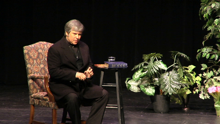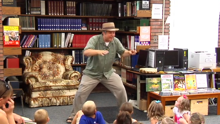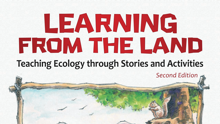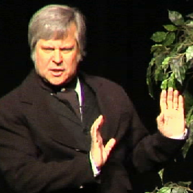A Keynote Address by Brian "Fox" Ellis
First published in Storytelling Magazine in 1992 and since reprinted in several journals.
Why is storytelling one of the most important things you can do in your classroom?
Anyone who has been teaching more than a few months knows that teachers are being asked to do more and more with each passing year. Over the past twenty years educators have seen a constant onslaught of state mandated curriculums, federal initiatives, administrative directives, and parent committee requests.
Instead of telling you that this is one more thing you need to add to the long list of duties and responsibilities of a classroom teacher, what I am saying is that simply by telling stories you are accomplishing many of the demands put upon modern educators by parents, principals, state and federal legislators.
Storytelling is the perfect embodiment of Whole Language pedagogy while encompassing phonemic awareness. It is interdisciplinary. Storytelling teaches higher level thinking skills. It addresses the needs of students with different learning styles. It provides opportunity for cooperative learning and building social skills. And most importantly storytelling has been shown to build intrinsic motivation and self-esteem, even in the students who are labeled hard to reach.
As professional educators it is important that we understand the pedagogical implications of our work. The following essay provides the theoretical basis for the use of storytelling in the classroom. My aim is to lift storytelling out of the fluff of something offered as a reward for good behavior, and to place it firmly at the core of the curriculum where it rightfully belongs. My hope is that storytellers and teachers will clip this article and make copies for the next time someone questions the need for spending more money on storytelling programs or the next time someone says “Oh, she was just telling stories.”
Why Tell Stories?
I. Storytelling is....
.... the embodiment of whole language and phonics.
.... the embodiment of whole language and phonics.
In every storytelling experience there is speaking and listening, and motivation for reading and writing. A good story well told embodies phonemic awareness in a whole language context.
Through storytelling students are actively involved in developing the skills necessary for effective public speaking. Namely, students learn the importance of clear articulation and dramatic interpretation. They gain first hand experience in the performing arts and an opportunity to enhance their self-esteem.
No other medium develops listening skills as effectively as storytelling. Stories stretch the audience's attention span and their imagination. Storytellers teach audience etiquette and the important concept of knowing when to listen quietly and when to listen actively by joining in. Listening to stories also improves vocabulary, which in turn improves site reading.
Any storyteller or librarian will attest to the fact that stories stir a student’s intrinsic motivation to read more books. A story performed well will be checked out of the library for months afterwards. Also, reading aloud is an important step in learning a story for the telling. Comprehension improves as evidenced by their re-telling and interpreting the story. And in a storytelling classroom students read each other’s writing, so writing is given more purpose.
Writing for a specific audience is a dynamic way to inspire, inform, and motive better writing. Students can write their own versions of a wide variety of tales, using basic folklore as a template for learning story form and story grammar. Through reading and listening, students are exposed to the joy and rhythm of language, which directly translates into clearer more fluid prose. Through performances they get immediate feedback on their writing, which improves editing skills. As a storyteller in residence the comment I hear most frequently is that storytelling not only inspired students to write more, but that it gave them the skills they needed to become better writers.
These four aspects of language development improve simultaneously: as students are involved in story telling (or listening or reading or writing) they are gaining language experience and developing skills which in turn helps them in the other three areas. Storytelling, more than any other medium, exemplifies this process and leads to a measurable improvement in the ability to communicate effectively.
Also, within the context of stories, lessons on grammar, phonics, spelling, point of view, plot, setting, characters, and many of the practical applications of language skills development are given depth and perspective. You can meet different learning styles by moving back and forth from the whole to the parts. The debate between whole language and phonics is an unnecessary argument between extremists. The teachers working in the classroom know that different students need different types of instruction, but storytelling provides the best context for these varying strategies.
II. Storytelling is....
.... Interdisciplinary ... and the perfect thread for tying the curriculum together!
.... Interdisciplinary ... and the perfect thread for tying the curriculum together!
Storytelling can enliven most any topic. Within every story there are many language arts lessons and opportunities for reading and writing skill development as outlined above. Events from history come to life in a story. Within every tale is information about the culture where the story began and opportunities for exploring cross cultural biogeography, or looking at the ways in which a culture relates to its ecosystem using folklore as the lens. Imbedded in the story is a wide array of facts and information about the cultures' relationship to their environment and their applied sciences like agriculture, fishing and hunting, herbal remedies, and architecture. Stories contain conflicts and hurdles to overcome: an opportunity to teach problem solving and applied mathematics. Within every tale there is an artistic mural waiting to be painted, a dance waiting to be choreographed, musical ballads, chants, and songs in foreign languages waiting to be sung.
If you would like to study another culture, one of the best ways to gain an understanding of their values, beliefs, and way of life is through their stories. Through their folktales and mythology you can see a group of people as they see themselves. A careful reading of the tale will answer a variety of questions about their political system, religious beliefs, economics and market systems, their relationship to the environment, their family and social structures, as well as what types of food, shelter, and clothing they used. Ways in which we are different and alike can also be highlighted to build a bridge between cultures. Not every story will answer every question, but it is amazing how much we can learn from a single story. For example, in "Jack and the Bean Stalk" we know they are farmers because they have a cow. They drink milk, eat bread and eat beans, which is a balanced vegetarian protein source. We also know that some people are poor like Jack and his mom and some are rich like the Giant, they have a class-consciousness. A single mother raised Jack. They believe in magic, the beans, and the supernatural, the Giant. In some versions of the story they talk about the king, so we know their political system was a monarchy.
Other branches sprouting from that vine include: a math lesson in which you could calculate the value of the cow versus the bags of gold, the golden harp, plus the golden eggs. Was there a profit? For science you could study domestic animals, milk and egg production, measure the rates of fast growing beans, explore the smells of “English Men” and olfactory sensitivity. You could decide as a class if Jack was guilty as a thief. You could hold a court case with students being judge, jury, defense attorney, prosecution, witnesses, and court reporters. In language arts you could teach phonics, vowel sounds, and rhyming patterns by writing your own rhyming verse like Fe, fi, fo, fum. You could write songs and translate the story into a musical production. Students could make a quilt of Jack Tales with each square representing one of his adventures. There are limitless interdisciplinary lessons waiting to be discovered in every story!
If I were in charge of a school that used an interdisciplinary, theme-based approach to education, I would begin each year with a unit on storytelling. Each grade level would focus on a different type of story: myths, legends, fairy tales, historical fiction, tall tales, etc. This would insure variety for the children as they progressed through the grades. Following this unit, every other theme-based unit throughout the year would include an element of storytelling! Stories can be used to introduce a concept or explain important theories. They can add depth and authenticity in the middle of a lesson. Students' stories are a clear indication of their ability to process the information and a valuable assessment tool at the end of a unit. Stories can become the warp upon which a teacher weaves the threads of the various content areas. Most importantly, storytelling and creative writing can tie the curriculum together and integrate ideas.
III. Storytelling is....
.... a perfect tool for meeting different learning styles.
.... a perfect tool for meeting different learning styles.
A well-balanced performance includes the spoken word and vivid descriptions for the auditory learner. It includes clear imagery, pantomime and the possibility of props for the visual learner. Stories contain emotional depth, conflict, and strong feelings for the affective learner. There is also an opportunity to participate, sing-a-long, or act it out for the kinesthetic learner. And by including a good balance of each learning style the storyteller is also challenging the audience to interact with the material using the other modes of learning and thereby stretching the learning skills of each audience member.
IV. Storytelling is....
.... a dynamic way to teach higher level thinking skills.
.... a dynamic way to teach higher level thinking skills.
Before, during or after a story, the listeners and teller could: recall basic facts, names, places, and the order of events; summarize the story, explain the main idea behind the story, or interpret the moral of the story; predict the end of the story having heard only the first half or brainstorm and problem solve ways to get the main character out of crisis; compare and contrast various characters in the story, different versions of the same story, different but similar stories; classify the story by type, the characters as good or evil, or the settings by geographical region; judge the villain in a mock trial; evaluate the teller by a predetermined scale that looks at technique, audience response, and interpretation of the material; observe the main character in a new, imaginary setting, make inferences about his / her behavior based on what you know; apply the information learned in a story to the creation of a new story.
With the popularity of retelling classic tales from other points of view there is a delightful opportunity to teach higher level thinking. Students could listen to or read the traditional story of the three pigs first and then the modern story from the point of view of the big bad wolf. They could make a Venn diagram to compare and contrast these stories. They could find three different classic versions of the story and evaluate each of these for ease of reading and enjoyment. You could hold a mock trial to judge the wolf. Students not on the jury could predict his guilt and give three reasons why they hold that opinion. These papers could be collected and discussed at the end of the trial. Students could rewrite another traditional tale from a different point of view.
This is just a partial list of possibilities. To be honest these are things that all children do naturally when given the opportunity. My three-year-old daughters recall words or scenes that I leave out of successive retellings. They judge characters as good or mean. They even evaluate performances, comparing and contrasting my telling of a tale versus the tape or teller where we learned the story. “He was funnier than you, daddy,” or “This is my favorite song because it makes me want to dance.” Using both critical and creative thinking skills is a natural part of the complex cognitive processing at any storytelling event.
V. Storytelling is....
.... cooperative learning.
.... cooperative learning.
Storytelling requires a sensitive interdependence between the performer and the audience; it is a duet of well-rehearsed oration and attentive listening. A cooperative audience and a performer who knows how to elicit the imagination of each listener are the key to a successful event. The experience forces the alert storyteller to honor the needs, desires and constant feedback from the audience. The audience in turn learns to follow the lead of the performer, to open their minds and hearts to new possibilities.
In a more pragmatic vein there are ample opportunities in a storytelling lesson to utilize the theory and practice of cooperative lesson planning, namely:
Circular storytelling games - in which someone begins a story, develops a plot or introduces the character or setting and then hands it off to the next person who adds to the story before passing it to the next person.... And so on around the circle.
Peer editing is a dynamic way to get feedback from a partner or team. Students could read or listen to a partner's story and help them to work out the details of the plot or correct spelling and grammar errors.
Small groups could each choose a story and act it out as a skit.
Teams could research the history and background of a story. Using the jigsaw strategy, each member of a group could become an expert on one aspect of the story. For example: if you were studying European history and the Grimms brothers, five areas students could explore include: cultural origin; historical period; symbols and metaphors; collectors and folklorists; and comparing different versions. Each student would do independent research to become an expert on one topic related to the group’s story. These experts could meet with their peers who are studying the same aspect of a different story and share notes. They would then come back to their team and each student would be responsible for teaching the other members of the team their area of expertise in relation to the story.
These are just four ways to capitalize on the benefits of cooperative learning in a storytelling unit. What are other ways to build on these models for helping students to learn the social skills and team building strategies so necessary in today’s work force?
Furthermore, research has shown that storytelling motivates hard to reach students, they participate more and learn more when storytelling is involved in the unit. More times than I could count, I have heard teachers say something along these lines, “DeMarko hates to write. He likes math and numbers, but he usually forgets to put his name on the paper. That is how much he hates writing. But after listening to stories and telling some of his own he has written a three page paper!”
Storytelling also elevates self-esteem by giving students a chance to perform, a chance to shine before their peers. Usually it is the class clown, (ME!), the one who is always in trouble, (again, this sounds familiar), who gives the best performance. They have not been given a chance to show their strengths in the typical classroom where being quiet and following orders are encouraged. Their spontaneity and sense of humor are constructively channeled by this experience and they achieve success. Isn’t it easier to build success on success? Logic and anecdotal research has shown that the communication skills learned in storytelling are carried over into improved test scores in other areas because one must first learn to read and write to comprehend the science or social studies text.
Storytelling also teaches coping skills and problem solving by giving them role models and alternative to violence for dealing with life’s everyday crises. Stories let the listener know that their problems are not so unusual, there are others with the same problems, who have survived creatively.
Storytelling develops empathy, understanding and cultural tolerance by exposing listeners to other cultures through the universal language of stories. Stories celebrate our differences, affirm our basic humanness, and build bridges of understanding.
Storytelling stimulates creativity by exposing students to a broader range of experience, life styles, and ways of thinking. If creative is the ability to recycle old ideas into new situations and combinations then the more raw material or life experience you have the more potential for creativity you have. Stories can give students a chance to travel the world, back and forth through time. They can try on different hats and empathetically experience other life styles. This is rich fodder for feeding the imagination.
Storytelling binds the listener to their community by giving them a sense of history and cultural identity.
We know that who we are is much more than a skin encased ego. Who we are is a culmination of decisions made by our forebears and the aspirations of those yet to come. Stories put our small lives in perspective so we grow larger in awareness of I and Thou.
Storytelling can teach moral development and the difference between right and wrong in a non-judgmental and "non-preachy" manner. By demonstrating through metaphor the implications of poor choices and the success one finds in correct behavior, stories model appropriate conduct. Fables, parables, Jataka tales, and koans have been passed down for thousands of years as guideposts or fingers pointing in the right direction, as gentle reminders that we are human, we make mistakes, and we can learn from our mistakes and go on. As a teacher, and more so as a camp counselor, I relished the experience of making up an animal story to highlight a mistake made by one of my charges. The light bulb came on when the child would say, “That raccoon is kind of like me isn’t it? I hadn’t thought about it that way before.”
For these reasons and more,
Storytelling is....
.... one of the most important tools any teacher can use in or out of the classroom!
.... one of the most important tools any teacher can use in or out of the classroom!









